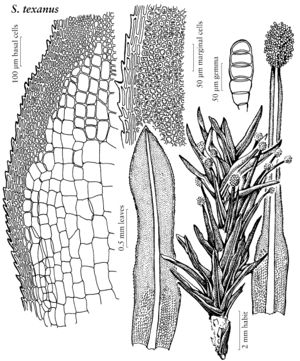Syrrhopodon texanus
Musc. Hepat. U.S., 103. 1856,.
Plants gregarious, tufted, to deeply caespitose, dark green to brownish when dry, to 3 cm but mostly much shorter. Leaves dimorphic, the vegetative 3–4 mm, loosely contorted when dry; distal lamina not reflexed, plane when moist, broadly linear, apex obtuse; margins bordered nearly to apex with hyaline cells, coarsely toothed-ciliate at shoulders and irregularly so to apex; medial cells distinct, 5 × 5–7 µm, bulging papillose adaxially, 1-papillose abaxially; cancellinae rounded or ending in acute angles distally; gemmiferous leaves terminal and in zones along stem, mostly rigidly erect wet and dry, consisting mostly of costa with narrow wings of lamina. Gemmae clavate-fusiform, smooth, abundant, forming pale spheres all around on excurrent tip of costa. Seta single, 15 mm. Capsule exserted, 2–5 mm; peristome teeth 120 µm, blunt, segmented.
Phenology: Spores mature Oct–Mar.
Habitat: Tree trunks and bases, stumps, rotted logs, soil on banks, and sandstone in forests
Elevation: low to moderate elevations (0-600 m)
Distribution

Ala., Ark., Del., Fla., Ga., Ill., Ky., La., Md., Miss., Mo., N.Y., N.C., Ohio, S.C., Tenn., Tex., Va., Mexico (Nuevo León)
Discussion
The bordered, coarsely toothed leaf margins and narrow, rigidly erect gemmiferous leaves make Syrrhopodon texanus easy to recognize. The gemmiferous leaves arise annually at the stem tips; old plants may have several zones of gemmiferous leaves along the stem representing annual increments, these separated by zones of vegetative leaves. In larger plants, proximal portions of the stems may be felted with rhizoids. Populations of this moss from interior states in the flora area are female or apparently asexual; male plants and sporophytes are known only from a relatively few sites along the Atlantic and Gulf coasts, and from a single station in northwestern Alabama (Marion County).
